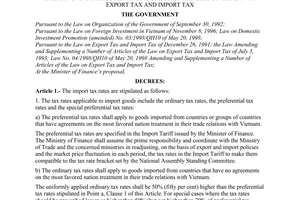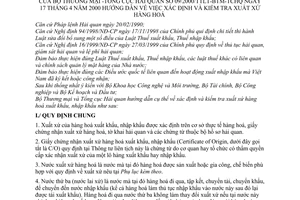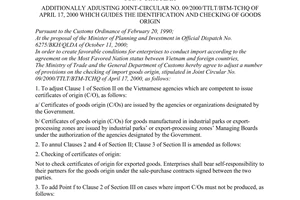Nội dung toàn văn Joint circular No. 09/2000/TTLT-BTM-TCHQ of April 17, 2000 guiding the identification and checking of goods origin
|
THE MINISTRY OF TRADE |
SOCIALIST REPUBLIC OF VIET NAM |
|
Hanoi, April 17, 2000 |
JOINT CIRCULAR
GUIDING THE IDENTIFICATION AND CHECKING OF GOODS ORIGIN
Pursuant to the Ordinance on
Customs of February 20, 1990;
Pursuant to the Government’s Decree No. 94/1998/ND-CP of November 17, 1998
detailing the implementation of the Law Amending and Supplementing a Number of
Articles of the Law on Export Tax and Import Tax;
Pursuant to the Government’s Decree No. 16/1999/ND-CP of March 27, 1999
stipulating the customs procedures, customs supervision and customs fees;
In order to ensure compliance with the Law on Export Tax and import Tax, other
relevant tax laws as well as the commodity management policy of the State;
In order to ensure compliance with the international agreements related to
export and import activities, which Vietnam has signed or recognized;
After consulting the Ministry of Science, Technology and Environment, the
Ministry of Finance, the Ministry of Industry and the Ministry of Planning and
Investment;
The Ministry of Trade and the General Department of Customs hereby jointly
provide the following specific guidance on the identification and checking of
the origin of imported and exported goods:
I. GENERAL PROVISIONS
1. The origin of imported or exported goods is identified on the basis of the actual goods, the certificates of origin of goods, the customs declaration forms and documents of the customs dossiers.
2. The certificates of origin of imported or exported goods (hereinafter called C/O for short) prescribed in this Joint Circular are documents issued by the competent agencies or organizations certifying the origin of a lot of imported or exported goods.
3. The country of origin of goods is a country where the goods are manufactured or processed in compliance with the provisions on goods origin in the appendix enclosed herewith.
4. The third country is a country where the goods are in transit, gathered, transshipped, or transported cross-border for further transportation to the importing country (including goods which are imported in such country for re-export). The origin of the goods going via a third country shall not be changed if in this country only several simple activities relating to goods preservation or packing are performed (the appendix enclosed herewith).
5. Where an international agreement, which Vietnam has signed or acceded to and has already come into force, contains provisions different from those of this Joint Circular, the provisions of that international agreement shall apply.
6. The exporters and importers shall be accountable before law for the legality and validity of the C/Os they present. All acts of fraudulence related to C/Os committed by importers or exporters shall be dealt with according to current provisions of law.
II. CHECKING THE ORIGIN OF EXPORTED GOODS
1. Vietnamese agencies competent to issue C/Os:
a/ Ordinary C/Os are issued by the Vietnam Chamber of Commerce and Industry or other competent agencies according to the provisions of law.
b/ C/Os of goods entitled to preferential treatment under the treaties or agreements between Vietnam and foreign countries, groups of countries or international economic organizations, are issued by the Ministry of Trade or agencies designated by the Government.
c/ C/Os of goods manufactured in industrial parks or export processing zones are issued by the management boards of these industrial parks or export processing zones.
2. C/Os are required for the following cases:
a/ Exported goods related to commitments stated in the international agreements with foreign countries or international organizations, which Vietnam has signed or acceded to.
b/ Other goods, if there is a provision on the C/O requirement in their commercial contracts.
3. Checking of C/Os:
a/ The customs offices shall check C/Os only when they doubt the authenticity of the C/Os which might be used to abuse the preferential treatment regime for goods subject to commitments on mutual preferential treatment signed between Vietnam and foreign countries, groups of countries or international economic organizations.
b/ The checking procedures shall be jointly effected by the customs offices and the agencies competent to issue C/Os.
4. Time for presentation of C/Os:
a/ The time for presentation of C/Os for checking is the time when the customs office receives the dossier of exported goods to carry out the procedures for registration of customs declaration forms.
b/ If, at the time the customs office receives the dossier of the exported goods for carrying out the procedures for registration of customs declaration forms, the exporter does not have a C/O, it may produce it later within 60 days after the date of registration of the customs declaration form. Pending the C/O, the customs office may carry out the export procedures if the exporter makes a written commitment and be responsible before law for the origin of the goods lot.
III. CHECKING THE ORIGIN OF IMPORTED GOODS
1. C/Os must be submitted to the customs offices in the following cases:
a/ Goods of origin from those countries offered by Vietnam the preferences in terms of import tariffs or other management regimes according to the Vietnamese laws or international treaties or agreements signed between Vietnam and foreign countries, groups of countries or international economic organizations and the importers wish to enjoy such preferences.
b/ Those kinds of goods which are announced by the State or international organizations to be then likely to cause harm to the community health or environmental hygiene.
2. C/Os are not required in the following cases:
a/ Imported goods of origin from countries not on Vietnam’s list of countries enjoying preferential import tariffs.
b/ Imported goods for which the importers do not ask for Vietnam’s preferential import tariffs.
c/ Non-commercial imported goods; non-quota imported goods; imported used goods; some agricultural produce being fresh flowers and fruits imported from countries sharing land border with Vietnam and other imported lots of commercial goods with a total value not exceeding 60 USD. The identification of the origins of the goods in these cases shall be based on the actual goods, the relevant documents and customs declarations forms filled in by the importers themselves, but the customs officers must clearly write the bases for identifying the goods origins and the countries of origin in the customs declaration forms. Where there are not enough bases for identifying the goods origins, the customs procedures shall be carried out according to the normal prescribed regime.
d/ Goods subject to an import tariff rate of 0% at the time they are imported and exempt from value added tax.
e/ Goods in transit.
3. Time for submission of C/Os
a/ The time for submitting C/Os to the customs office is the time the customs office receives the dossiers of imported goods for carrying out the procedures for registration of the customs declaration forms.
b/ At the time of carrying out the procedures for registration of the customs declaration forms, if the importers have no C/Os to submit to the customs offices, they must make a written request for late submission of C/Os. Pending the C/Os, the customs offices shall carry out the customs procedures according to the normal regime.
c/ The time for submission of the written requests for late C/O submission is the time of registration of the customs declaration forms. The maximum time for late C/O submission is 60 days from the date of registration of the customs declaration forms.
4. Mode and form of C/Os:
a/ C/Os submitted to the customs offices must be the originals containing in full the following principal contents:
- The issuance number of the C/O
- The name and address of the exporter; the exporting country.
- The name and address of the importer; the importing country.
- Information on goods transportation (place of loading goods onto the transport means, place of destination).
- The trademark and label; the number and type of packs; description of goods.
- Weight.
- The goods origin.
- The enterprise requesting the issuance of C/O (the enterprise’s name, the date of request for issuance)
- The C/O-issuing organization (the organization’s name, the date of issuance, stamp).
b/ Where a C/O is not made in English or French, it must be enclosed with a translation either notarized or signed and stamped by the company’s director who shall be responsible for it. If a C/O contains some correction or erasure, the agency or organization that issues the C/O must affix a stamp attesting to such correction or erasure.
c/ C/Os must be issued by the competent agencies as prescribed by the C/O-issuing countries (the Ministry of Trade, the Ministry of Industry, the Ministry of Finance, the Customs Service...) or other organizations designated by the State (normally the Chamber of Commerce or the Chamber of Commerce and Industry). Where a C/O is issued by the manufacturer, it must be certified by the concerned competent agency or organization of the issuing country.
d/ The date of issuance of C/O may be before or after the date of loading the goods onto the transport means, but must comply with the provisions on the prescribed time for late submission.
e/ A C/O may be issued to certify the origin of several goods items of the same lot of imported goods and valid only for that lot.
f/ A C/O which is re-issued due to loss or misplacement must be inscribed with the words "Sao y ban chinh" in English "Certified true copy".
g/ For C/Os presented not at the prescribed time due to force majeure events or a plausible reason, the directors of the provincial/municipal Customs Departments shall consider on the case-by-case basis and direct the settlement according to their competence.
h/ C/Os already submitted to the customs offices cannot be changed or amended. The consideration of the goods origins shall be based on the submitted C/Os. The customs office where the import/export procedures are carried out shall accept a new C/O only in cases where there are mistakes attested to by the C/O-issuing organizations.
5. Checking C/Os:
a/ C/Os must be checked to ensure their compliance with the provisions stated at Point 4 above; the principal contents of a C/O must match the documents accompanying the goods lot as well as the goods already going through customs inspection. If the contents of a C/O contains some disparities with the other documents but the customs offices deem that such disparities do not affect the identification of the goods origin, they can accept such C/O and proceed with the customs procedures.
b/ Where the customs offices doubt the authenticity of a C/O they shall request the goods owner to supply more documents to prove it. The time for the goods owner to produce more documents proving his/her C/O is 90 days, counting from the date of registration of the customs declaration forms; the customs offices shall carry out the prescribed preferential procedures only after the goods owner manage to produce documents proving the validity of the C/O.
c/ For goods imported from countries and territories of countries that enjoy the most favored nation (MFN) status, when carrying out the importing procedures, if the goods owners produce C/Os of the normal form issued by the competent organizations or agencies of the exporting countries, the customs offices shall accept such C/Os without checking and comparing the organizations’ names, specimen stamps and signatures with those on the C/Os.
6. C/O requirements for goods imported via a third country:
a/ For goods manufactured in a country eligible for preferential treatment but imported from a third country which is also eligible for preferential treatment, the customs offices shall accept the C/O issued by the third country.
b/ For goods of origin from a country eligible for preferential treatment but imported from a third country not eligible for preferential treatment, the customs offices shall accept the C/O issued by the third country, which is enclosed with the copy of the C/O of the country of origin.
c/ Where the goods are sold through several countries before coming to the importing country, the last country from which the goods come to the importing country is regarded as third country.
d/ The sale and purchase of goods via a third country as an intermediary but the goods are transported directly from the manufacturing country to Vietnam without going through the intermediary country, the customs offices shall accept the C/O of the manufacturing country given that such C/O matches with such documents as bill of lading, goods descriptions.
7. Other cases:
a/ Where the importer has a C/O for the whole lot of goods but only part of the goods lot is imported, the customs offices shall accept the C/O, which is issued for the whole lot of goods, for the actually imported volume of goods.
b/ Where the goods have their components and/or spare parts made in different countries and assembled in one country, the customs offices shall accept the C/O issued by the country where the products are completely assembled. The assembling country shall be recognized as the country of origin of goods if the assembling activities are not on the list of simple activities prescribed in the attached Appendix;
c/ For re-imported goods and returned exported goods of origin from Vietnam, the customs offices only need to match the set of documents of the previously exported goods with those of the actually imported goods; if the names, signs and codes and specifications of the goods are alike, they shall accept to carry out the re-import procedures as prescribed, without requesting for C/O.
8. The customs offices only consider and settle problems related to goods origin within one year from the date of registration of customs declaration forms.
IV. ORGANIZATION OF IMPLEMENTATION
1. This Joint Circular takes effect 15 days after its signing. All earlier guiding regulatory documents on the origin of exported and imported goods are hereby annulled (with the exception of the documents prescribing the goods origin under the international treaties or agreements which Vietnam has signed or acceded to).
2. The provincial/municipal Customs Departments and Trade Services shall base themselves on the above provisions for implementation and jointly report any arising problems to the General Department of Customs and the Ministry of Trade for direction on their settlement.
|
FOR THE MINISTER OF TRADE |
FOR THE GENERAL DIRECTOR OF CUSTOMS |
APPENDIX
PROVISIONS ON GOODS ORIGIN
1. Goods of pure origin:
Products of natural origin or products which are worked or processed without imported materials and raw materials or those of unclear origin, are called goods of pure origin. These products include:
a/ Articles of minerals exploited from the subsoil, from the water areas of the country or from the seabed or ocean.
b/ Articles of origin from vegetation planted in the country.
c/ Species of animals born and raised in the country.
d/ Articles processed from animals living in the country.
e/ Products of hunting and fishing, which are processed in the country.
f/ Products of marine fishing and other products exploited from the sea, which are aboard ships of the country.
g/ Articles made aboard ships with the processing function, of the country, for products stated at Item (f) only.
h/ Products exploited from the subsoil or seabed outside the water territories of the country and it is prescribed that such country has the exclusive right to exploitation on the land area or beneath such land area.
i/ Discarded material and waste materials from processing activities and useless articles gathered in the country, which may be only recycled for use as initial materials.
j/ Goods manufactured in the country, only from products stated from Items (a) to (i) above.
2. Goods of impure origin:
- Goods of impure origin are those being manufactured or processed or worked from materials and raw materials or by labor of two or more countries participating in the creation of these products.
- Goods of impure origin are recognized as being of origin from the country where they are processed or worked at the final stage and such processing activities are other than the following simple operations:
a/ Goods preservation during the transportation and storage process (air ventilation, spreading, drying, freezing, soaking in salt, sulfuric smoking, or adding with other additives, removal of damaged parts and similar work).
b/ Simple job like dusting, sorting, selecting, categorizing (including set arranging), cleaning, painting and portioning.
c/ i. Changing wrappings, unloading or assembling of goods lots;
ii. Bottling, packing and other simple packing work.
d/ Affixing onto products or their packages labels, trademarks or similar marking signs.
e/ Simple mixing of products, including different components, if one or more constituents of the mixtures fail to meet the prescribed conditions for consideration of being of origin from the place where this work is carried out.
f/ Simple assembling of parts to create complete products.
g/ Combination of two or more jobs listed from a to f.
h/ Animal slaughtering.-



